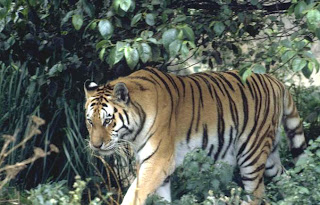sundarban is the single block of tidal halophytic mangrove forest in the world . The name may have been derived from the sundari tree's are found in sundarban in large number's the largest mangrove forest in the world (140.000 ha) . World famous royal bengal tiger's homeland and about 400 tiger's live in sundarban . about 30.000 beautiful spotted deer live in sundarban . 150.000 very very beautiful and note monkey live in sundarban . there are over 120 different species fish in sundarban , not less then 270 variety of bird's are found . More then 50 species of amphibion's are known occur in sundarban . The sundarban now supports the only population of the estuaring or salt water crocodile in bangladesh .
 While as a tourist
you are unlikely to face any danger from the local wildlife, it is wise to be
informed that two of the most potentially dangerous animals on Earth reside
within the Sundarbans. The Sundarbans is well known as the only place left
where Bengal Tigers still hunt and kill humans, and they do it regularly. That
being said, these victims are always locals who live within the Sundarbans and
rely on it for survival, hence there is a "live and let live" policy
between man and tiger. Saltwater Crocodiles also inhabit the Sundarbans and are
well known to be the largest and (along with the Nile Crocodile) most
aggressive reptile on Earth. In the Sundarbans you are unlikely to be in
crocodile territory without a large boat, so the risk is minimal. As you can
see, while living in the Sundarbans is extremely dangerous, very little risk is
posed to the average tourist. Snakes exist, but are primarily either shy or
nocturnal, unless you plan on venturing off into the bush alone you don't have
much to worry about.
While as a tourist
you are unlikely to face any danger from the local wildlife, it is wise to be
informed that two of the most potentially dangerous animals on Earth reside
within the Sundarbans. The Sundarbans is well known as the only place left
where Bengal Tigers still hunt and kill humans, and they do it regularly. That
being said, these victims are always locals who live within the Sundarbans and
rely on it for survival, hence there is a "live and let live" policy
between man and tiger. Saltwater Crocodiles also inhabit the Sundarbans and are
well known to be the largest and (along with the Nile Crocodile) most
aggressive reptile on Earth. In the Sundarbans you are unlikely to be in
crocodile territory without a large boat, so the risk is minimal. As you can
see, while living in the Sundarbans is extremely dangerous, very little risk is
posed to the average tourist. Snakes exist, but are primarily either shy or
nocturnal, unless you plan on venturing off into the bush alone you don't have
much to worry about.
Sundarbans is home to many different species of birds, mammals, insects,
reptiles and fishes. Over 120 species of fish and over 260 species of birds
have been recorded in the Sundarbans. The Gangetic River Dolphin (Platanista
gangeticus) is common in the rivers. No less than 50 species of reptiles and
eight species of amphibians are known to occur. The Sundarbans now support the
only population of the Estuarine, or Salt-Water Crocodile (Crocodylus parasus)
in Bangladesh,
and that population is estimated at less than two hundred individuals.
The park is also home to sea gypsy fishing families
who catch fish using trained otters.



No comments:
Post a Comment